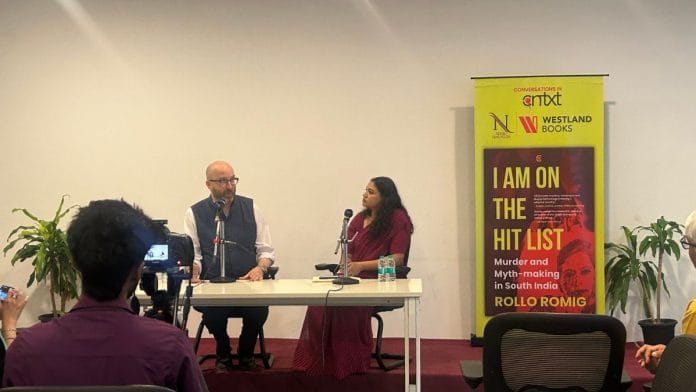New Delhi: Gauri Lankesh often joked that she was on a hit list. American journalist Rollo Romig made it the title of his Pulitzer finalist book on the activist and editor who was assassinated outside her home on 5 September 2017.
“There actually was a hit list,” said Romig in conversation with journalist and author Neha Dixit at Jawahar Bhawan in New Delhi last month.
His book, I Am on the Hit List: Murder and Myth-Making in South India, explored how Lankesh was one of many activists and rationalists who had been murdered, including Narendra Dabholkar, Govind Pansare, and MM Kalburgi.
“She made a point of smoking and drinking, partly because she knew that it annoyed certain people,” he said. While many female journalists have, over the years, been attacked and targeted, Lankesh’s case became possibly the only one where a woman journalist was assassinated, he added.
What began as a reporting assignment after Lankesh’s 2017 assassination soon turned into an inspiration for writing the book. Romig first arrived in Bengaluru intending to write a short piece, but, as he put it, “the more I learned, the more I realised I was only seeing the edges of a much bigger tapestry.”
He began speaking to Lankesh’s friends, rivals, and colleagues, tracing the threads of her life through old articles, court records, and late-night conversations. Slowly, he started untangling the many weaves of her story, its complexities, contradictions, and the wide-ranging network she had built.
The audience listened with rapt attention, occasionally gasping at the horrific details Romig revealed, the room thick with a mix of shock and fascination. “The thing that sustained me the most and ended up fascinating me the most over this time that I was working on this book, that, you know, she was such a complex person who went through many different phases in her life,” he told the audience.
The Special Investigation Team, in its chargesheet, named the Goa-headquartered Hindutva group Sanatan Sanstha as the ‘chief perpetrator’.
Romig stressed that writing the book came from a position of “enormous privilege” and that his experience could not be compared to the dangers faced by Indian journalists. While he occasionally felt nervous during certain meetings, he faced no real threats, not even online abuse after publication. “There’s no comparison to what Indian journalists living in India have to face,” he said, recalling that Lankesh endured harassment long before social media, including piles of obscene postcards sent to her office.
Journalist, activist, and a ‘target’
To many people who knew Lankesh, she was a journalist, but to others, she was an activist. However, over the years, Lankesh went through an evolution. “By the end, she had flipped the equation, and she described herself as an activist journalist, putting the word activist up front,” said Romig.
But what remained constant was her passion and her sense of community building.
Her murder shocked the nation.
In the final years of her journalism, Lankesh openly began rejecting the idea of journalistic neutrality, especially as she increasingly focused her writing on the right-wing ecosystem, the Rashtriya Swayamsevak Sangh (RSS), and its ideological allies. Romig said that this came with certain consequences, including multiple legal cases, threats, and, finally, a defamation conviction for naming BJP legislators.
Yet, over everything else, Romig said that her community work and the connections she built with common people remained the core of what she did, and when people lost her, “that was where they found the gap most profoundly, that no one else was filling.”
Also read: KM Panikkar was a scapegoat. It was easier to blame him for China than Nehru
Recognising common cause
As the conversation drew to a close, Romig was asked why Lankesh’s story became the one he chose to tell. To this, he said, “I feel so lucky to have had access to the world Gauri inhabited… It’s been the great privilege of my life.”
Throughout researching on Lankesh’s life and death, Romig said that her life encapsulated many of the anxieties, struggles, and ruptures of India over the past decade, noting that Lankesh was also one lens among many. “There are countless people you could frame a book around and tell a very different story,” he said.
When someone in the audience asked how today’s activists, working across scattered movements, could draw from Lankesh’s approach to community, Romig pointed to her quiet labour of connection, introducing people, finding common ground, and unifying scattered efforts.
“She was brilliant at recognising when different fights had common cause,” Romig said, suggesting, “the scariest thing for the regime would be if all those fighting separate battles came together.”






